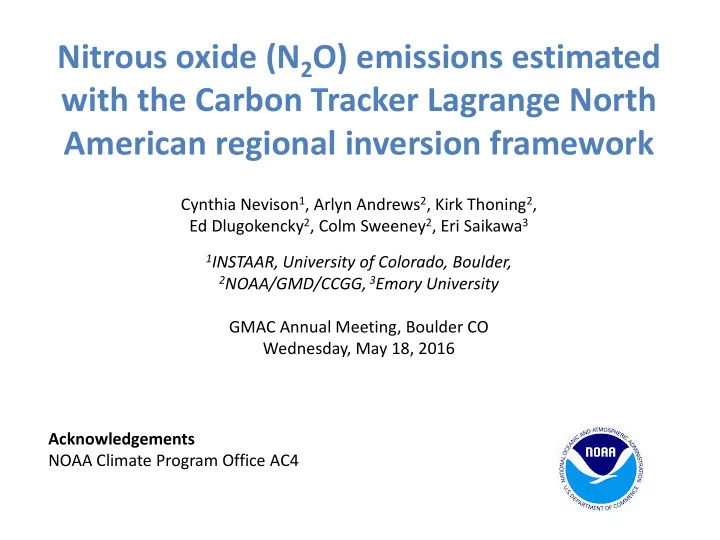

Nitrous oxide (N 2 O) emissions estimated with the Carbon Tracker Lagrange North American regional inversion framework Cynthia Nevison 1 , Arlyn Andrews 2 , Kirk Thoning 2 , Ed Dlugokencky 2 , Colm Sweeney 2 , Eri Saikawa 3 1 INSTAAR, University of Colorado, Boulder, 2 NOAA/GMD/CCGG, 3 Emory University GMAC Annual Meeting, Boulder CO Wednesday, May 18, 2016 Acknowledgements NOAA Climate Program Office AC4
Nitrous Oxide (N 2 O) Natural, long-lived GHG increasing at about 0.3%/yr in • the atmosphere Responsible for 6% of anthropogenic radiative forcing • (GWP ~ 300) Produced mainly by microbial cycling of nitrogen at • Earth’s surface and destroyed photochemically in the stratosphere
Motivations 1) Characterize North American N 2 O emissions. 2) Examine role of agriculture.
Carbon Tracker Lagrange Regional inverse modeling framework • Jan-Dec 2012, 24-hour time step • North America 1°x1° (10°-80°N, 170°-50°W) • Ground and aircraft data from NOAA GGGRN (n =7,281) • H matrix from STILT particle back trajectories L s = 0.5*( z - Hs ) T R -1 ( z - H s) + 0.5( s - s p ) T Q -1 ( s - s p ) s p = prior fluxes. Solve for optimal flux vector s z = vector of observations – background
NOAA Empirical Background Product (Arlyn Andrews et al.) 75°-85°N 65°-75°N 55°-65°N 45°-55°N 35°-45°N 25°-35°N Anomalies after subtracting MLO data
NOAA data compared to Empirical Background Alaska Iowa
Large Excursions above Background
Posterior Annual Mean Results: 3 different priors Saikawa Global Inversion 10% of N Fertilizer Flat Prior
Crop Area
Crop Area Wheat Corn/Soybean Variety Cotton Wheat/Cotton
Maximum N 2 O Flux in Springtime
If N 2 O all came from N Fertilizer, what would the emission fraction be? 4-5% ~8% ~10% ~20% ~11% Fertilizer Map from University of Wisconsin
N Fertilizer Consumption Data from FAOSTAT
United States Crop Area Oilcrops, Cotton Pulses Other 3% 1% 5% Nuts Roots and Tubers 0% 1% Fruit&Vegetables 2% Wheat Cereals, Other 18% 6% Soybeans 30% Corn 34% 2013 data from FAOSTAT
Oilcrops, Cotton Pulses The New Face of Hunger Other 3% 1% 5% Nuts Roots and Tubers National Geographic , Aug 2014 0% 1% “It is a cruel irony that Fruit&Vegetables people in rural Iowa can 2% Wheat be malnourished amid Cereals, Other 18% 6% forests of cornstalks running to the horizon. Iowa dirt is some of the richest in the nation …” Soybeans 30% Corn 34%
Conclusions 1. North American N 2 O emissions, according to CTL inversion, are 1.4 ± 0.3 Tg N/yr. 2. More than half of these emissions come from the Central U.S. (105°-80°W), with about 0.35 ± 0.03 Tg N/yr from the corn/soybean belt.
Anthropogenic N 2 O source is relatively well constrained by observed growth rate and the known stratospheric sink Global Anthropogenic N 2 O source Tg N/yr Box Model ~ 6 (top-down) EDGAR 7 (bottom up inventory)
Prior vs. posterior fit to observations at individual sites
Recommend
More recommend